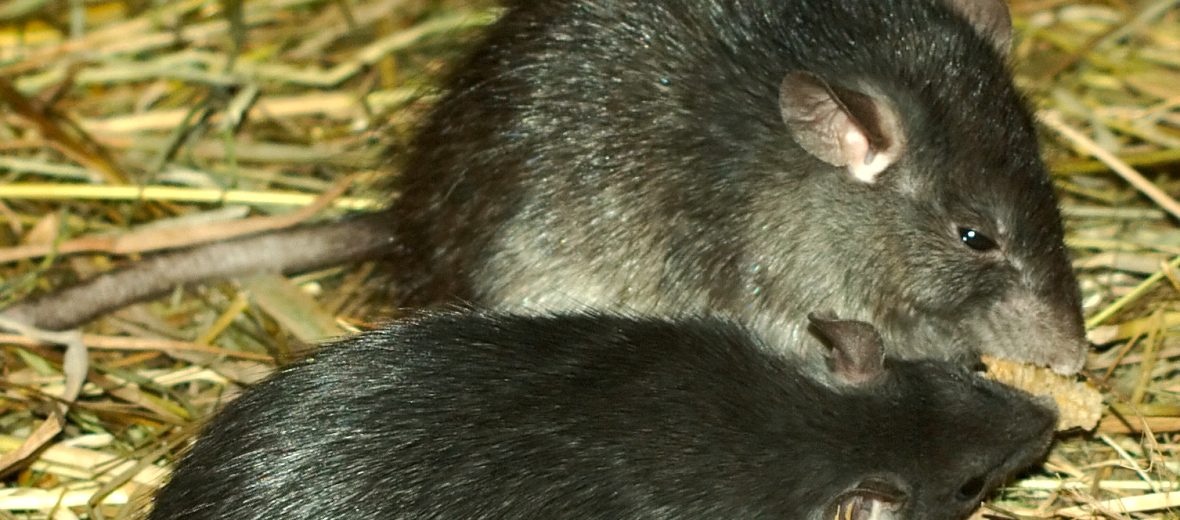
The black rat, aka roof rat, house rat, ship rat, Alexandrine rat, Old English rat, or trodman, can be found throughout the world; even Antarctica. These rodents are highly adaptable and can live in a multitude of environments; hence their often invasive nature. These rats have actually been sometimes responsible for the near or complete extinction of other animal species. With no clear and present natural threats and a stable and growing population, these rats are listed as Least Concern by the IUCN.
First the Stats…
Scientific name: Rattus rattus
Weight: Up to 8.1 ounces
Length: Up to 7.19 inches, plus up to a 8.7 inch tail
Lifespan: Up to 4 years
Now on to the Facts!
1.) It is believed that these rodents originally hail from India and Indo-Malaysia.
2.) Due to their inclination towards seafaring vessels, they have been introduced to every continent in the world, yet have a tendency to dwell near coastal regions.
3.) They are excellent climbers and strong swimmers. It is presumed that they also spread to nearing islands via swimming to them. They have also been known to swim in open water.
4.) It was the Romans who were to blame for introducing black rats to Britain.
5.) Black rats are nocturnal (active at night) and awaken just after sunset to begin their nightly activities.
But wait, there’s more on the black rat!
6.) These rats are highly intelligent and social animals that form packs of 2 or more dominant females and several males, 1 of which is considered the dominant male.
7.) Rat packs are primarily matriarchal (led by females). However, the dominant male doesn’t submit to the dominant females, but rather will form their own linear male hierarchy.
Did you know…?
In India, these rodents are sometimes kept as pets, albeit short-lived, and they are considered sacred & respected animals in the Karni Mata Temple, in Deshnoke.
8.) Contrary to other matriarchal societies, females are substantially more aggressive than males.
9.) These rodents can be considered either arboreal (spend their lives in trees) or terricolous (terrestrial – ground dwelling), based on their locale.
10.) Dominance is established via aggressive threat postures and even physical contact.
But wait, there’s still more on the black rat!
11.) Black rats are very vocal critters and produce squeaking sounds when either threatened or when communicating with one another.
12.) Territories are denoted via an oily substance produced from their sebaceous glands located in their ears, prepuces (skin folds), clitoris, and anus.
Did you know…?
The “Black Death” or bubonic plague, which claimed millions of human lives back in medieval times, was spread by black rats. This is mostly due to the fleas on their body, which carried numerous diseases that are extremely dangerous, and deadly for humans and livestock alike.
13.) These rats, like other rats, have keen senses of hearing, smell, touch, and vision.
14.) A group of rats is called a colony, horde, mischief, pack, plague, or swarm.
15.) Being omnivores (eat plant and animal matter) these critters feast on cereals; fruit; grain; nuts; and invertebrates, like insects and grubs.
But wait, there’s still a little more on the black rat!
16.) Black rats are polygynous (1 male mates with multiple females).
17.) Nests are constructed from various shredded materials, like leaves, sticks, various vegetation, fabric, and more, and are spherical in design.
Did you know…?
With a strong memory and a high level of intelligence, black rats are thought to be more intelligent than gerbils, guinea pigs, hamsters, mice, or rabbits. They are capable of learning direction-finding routes, and they remember said routes throughout their life.
18.) If there is an absence of nesting material, they will simply dig burrows in the ground.
19.) Females undergo up to a 29 day gestation (pregnancy) that can yield a whopping 16 pups!
20.) Pups are independent in up to 4 weeks and able to reproduce in just 2 months! Hence their propensity towards being invasive.
But wait, there’s still a tad more on the black rat!
21.) Black rats are known for engaging in group play activities and they will sleep nestled up together. Rats are also caring of injured and sick members of their pack.
22.) That being said though, if highly stressed and confined, these rats can often turn on the weaker of the pack and viciously kill them. I have unfortunately witnessed this before.
Did you know…?
During REM sleep or when tickled, these rats will emit an inaudible almost giggle.
23.) The Romans viewed rats as a sign of good luck.
24.) These critters are often shy and will typically flee from danger rather than face it.
25.) A little known fact too is that rats are usually right-handed.
But wait, there’s still a couple more facts on the black rat!
26.) Rats are color blind.
27.) They get 1 of their common names, “roof rat” because of their tendency to build nests high in roof spaces.
28.) Black rats are smaller than brown rats.
Now a Short Black Rat Video!
Be sure to share & comment below! Also, check out the Critter Science YouTube channel. Videos added regularly!
Want to suggest a critter for me to write about? Let me know here.
Some source material acquired from: Wikipedia & IUCN
Photo credit: Kilessan



